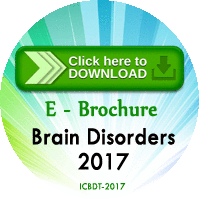
Ekaterina Zubrickaya
Krasnoyarsk State Medical University, Russia
Title: The method of cognitive functions recovery after traumatic brain injury applying author’s computer programs
Biography
Biography: Ekaterina Zubrickaya
Abstract
Background & Aim: Traumatic brain injury (TBI) has been one of the most topical issues in medicine around the world. Epidemiological studies demonstrate an extremely high frequency of TBI in Russia about 600,000 people annually, and up to four and more persons per 1000 persons a year. According to the rate of injuries in developed countries in terms of overall economic and socio-medical damage to the society, TBI is the first one. The average age of the injured varies from 23 to 39.6, which affects the most economically and socially active group. The prevalence of cognitive impairments depending on the severity of the injury, according to many authors, stands at 70 to 100%. In the patients with concussion it is as high as 93.75%, with mild brain injury of 90%, with moderate-to-severe injury of 98.6%. Therefore, further research into the cognitive impairment treatment after brain injury is both medically and socio-economically important and constitutes an urgent issue at the present time.
Results & Discussion: None of the electroencephalograms of the 15 examined revealed epiactivity; 12 patients (80%) underwent operative intervention; 11 patients (73.3%) were in coma for over 10 days. As for neuropsychological impairments, all patients were diagnosed with cognitive impairments of a mild (66.7%) and large (33.3%) degree. Particularly notable is the prevalence of impairments involving inhibition of the rate of mental activity, calculation, memory, and visual spatial cognition. As a result of the treatment course that involved computer-assisted training, the patients showed statistically significant improvements in relation to the neuropsychological screening tests: MMSE (p=0.07, Ме1=25, Ме2=27), FAB (p=0.01, Ме1=15, Ме2=16), Schulte tables (p=0.01, Ме1=47, Ме2=38.6), clock-drawing test (р=0.01, Ме1=8, Ме2=9), level of anxiety as per HADS (р=0.02, Ме1=3, Ме2=2) and level of depression as per HADS (р=0.04, Ме1=2, Ме2=2), Luria 10-word memory test with immediate recall (р=0.007, Ме1=6, Ме2=7), abstract reasoning test with 6 figures (р=0.005, Ме1=16, Ме2=20), verbal reasoning test with literal stimuli (р=0.007, Ме1=11, Ме2=13) and categorical reasoning test (р=0.01, Ме1=10, Ме2=12). The incomplete figure perception test did not prove to be statistically significant (р=0.17, Ме1=6, Ме2=6). As a result of the training course, there was a strong tendency towards statistical significance of improvement in relation to the 10 word memory test with delayed recall (р=0.06, Ме1=5, Ме2=6). The examined patients mentioned subjectively estimated improvement in attention and concentration (81.8%), higher daily activity, lower level of emotional and volitional disorders (72.7%).
Conclusion: Thus cognitive impairments occurring after TBI are a widely spread symptom significantly affecting the performance efficiency and welfare of patients. The first experience in application of computer-assisted training to address the cognitive impairments in patients with moderate-to-severe TBI proved to be successful. Based on the data from the conducted pilot study, this method may be recommended as a part of the comprehensive rehabilitation treatment of patients with cognitive impairments in the interim and residual periods of TBI.

